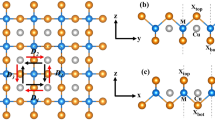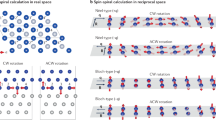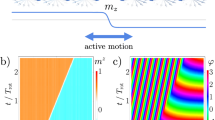Abstract
Topological defects such as magnetic solitons, vortices and skyrmions have started to play an important role in modern magnetism because of their extraordinary stability1, which can be exploited in the production of memory devices. Recently, a type of antisymmetric exchange interaction, namely the Dzyaloshinskii–Moriya interaction (DMI; refs 2,3), has been uncovered and found to influence the formation of topological defects4,5,6,7. Exploring how the DMI affects the dynamics of topological defects is therefore an important task. Here we investigate the dynamics of the magnetic domain wall (DW) under a DMI by developing a real time DW detection scheme. For a weak DMI, the DW velocity increases with the external field and reaches a peak velocity at a threshold field, beyond which it abruptly decreases. For a strong DMI, on the other hand, the velocity reduction is completely suppressed and the peak velocity is maintained constant even far above the threshold field. Such a distinct trend of the velocity can be explained in terms of a magnetic soliton, the topology of which is protected during its motion. Our results therefore shed light on the physics of dynamic topological defects, which paves the way for future work in topology-based memory applications.
This is a preview of subscription content, access via your institution
Access options
Subscribe to this journal
Receive 12 print issues and online access
$259.00 per year
only $21.58 per issue
Buy this article
- Purchase on SpringerLink
- Instant access to full article PDF
Prices may be subject to local taxes which are calculated during checkout




Similar content being viewed by others
References
Braun, H.-B. Topological effects in nanomagnetism: From superparamagnetism to chiral quantum solitons. Adv. Phys. 61, 1–116 (2012).
Dzyaloshinskii, I. A thermodynamic theory of “weak” ferromagnetism of antiferromagnetics. J. Phys. Chem. Solids 4, 241–255 (1958).
Moriya, T. Anisotropic superexchange interaction and weak ferromagnetism. Phys. Rev. 120, 91–98 (1960).
Fert, A., Cros, V. & Sampaio, J. Skyrmions on the track. Nature Nanotech. 8, 152–156 (2013).
Thiaville, A., Rohart, S., Jué, É., Cros, V. & Fert, A. Dynamics of Dzyaloshinskii domain walls in ultrathin magnetic films. Europhys. Lett. 100, 57002 (2012).
Emori, S., Bauer, U., Ahn, S.-M., Martinez, E. & Beach, G. S. D. Current-driven dynamics of chiral ferromagnetic domain walls. Nature Mater. 12, 611–616 (2013).
Ryu, K.-S., Thomas, L., Yang, S.-H. & Parkin, S. Chiral spin torque at magnetic domain walls. Nature Nanotech. 8, 527–533 (2013).
Malozemoff, A. P. & Slonczewski, J. C. Magnetic Domain Walls in Bubble Materials (Academic Press, 1979).
Mikeska, H. J. Solitons in a one-dimensional magnet with an easy plane. J. Phys. C 11, L29–L32 (1978).
Hubert, A. & Schäfer, R. Magnetic Domains (Springer, 1998).
Ono, T. et al. Propagation of a magnetic domain wall in a submicrometer magnetic wire. Science 284, 468–469 (1999).
Yamaguchi, A. Real-space observation of current-driven domain wall motion in submicron magnetic wires. Phys. Rev. Lett. 92, 077205 (2004).
Allwood, D. A. et al. Magnetic domain-wall logic. Science 309, 1688–1692 (2005).
Parkin, S. S. P., Hayashi, M. & Thomas, L. Magnetic domain-wall racetrack memory. Science 320, 190–194 (2008).
Schryer, N. L. & Walker, L. R. The motion of 180° domain walls in uniform dc magnetic fields. J. Appl. Phys. 45, 5406–5421 (1974).
Nakatani, Y., Thiaville, A. & Miltat, J. Faster magnetic walls in rough wires. Nature Mater. 2, 521–523 (2003).
Lee, J. Y., Lee, K. S. & Kim, S. K. Remarkable enhancement of domain-wall velocity in magnetic nanostripes. Appl. Phys. Lett. 91, 122513 (2007).
Yan, M., Andreas, C., Kákay, A., Garcia-Sánchez, F. & Hertel, R. Fast domain wall dynamics in magnetic nanotubes: Suppression of Walker breakdown and Cherenkov-like spin wave emission. Appl. Phys. Lett. 99, 122505 (2011).
Burn, D. M. & Atkinson, D. Suppression of Walker breakdown in magnetic domain wall propagation through structural control of spin wave emission. Appl. Phys. Lett. 102, 242414 (2013).
Bryan, M. T., Schrefl, T., Atkinson, D. & Allwood, D. A. Magnetic domain wall propagation in nanowires under transverse magnetic fields. J. Appl. Phys. 103, 073906 (2008).
Ueda, K. et al. Transition in mechanism for current-driven magnetic domain wall dynamics. Appl. Phys. Express 7, 053006 (2014).
Kim, K.-J. et al. Trade off between low-power operation and thermal stability in magnetic domain-wall-motion devices driven by spin Hall torque. Appl. Phys. Express 7, 053003 (2014).
Taniguchi, T. Different stochastic behaviors for magnetic field and current in domain wall creep motion. Appl. Phys. Express 7, 053005 (2014).
Metaxas, P. J. et al. Creep and Flow Regimes of magnetic domain-wall motion in ultrathin Pt/Co/Pt films with perpendicular anisotropy. Phys. Rev. Lett. 99, 217208 (2007).
Slonczewskii, J. C. Theory of Bloch-line and Bloch-wall motion. J. Appl. Phys. 45, 2705–2715 (1974).
Kim, S.-K., Lee, J.-Y., Choi, Y.-S., Guslienko, K. Y. & Lee, K.-S. Underlying mechanism of domain-wall motions in soft magnetic thin-film nanostripes beyond the velocity-breakdown regime. Appl. Phys. Lett. 93, 052503 (2008).
Guslienko, K. Y., Lee, J.-Y. & Kim, S.-K. Dynamics of domain walls in soft magnetic nanostripes: Topological soliton approach. IEEE Trans. Mag. 44, 3079–3082 (2008).
Chetkin, M. V., Parygina, I. V., Roman, V. G. & Savchenko, L. L. Unidirectional collisions of vertical Bloch lines. Sov. Phys. JETP 78, 93–97 (1994).
Wang, X. S., Yan, P., Shen, Y. H., Bauer, G. E. W. & Wang, X. R. Domain wall propagation thorough spin wave emission. Phys. Rev. Lett. 109, 167209 (2012).
Wieser, R., Vedmedenko, E. Y. & Wiesendanger, R. Domain wall motion damped by the emission of spin waves. Phys. Rev. B 81, 024405 (2010).
Mizukami, S. Gilbert damping in Ni/Co multilayer films exhibiting large perpendicular anisotropy. Appl. Phys. Express 4, 013005 (2011).
Acknowledgements
We thank H. Tanigawa, T. Suzuki and E. Kariyada for providing us with high-quality Co/Ni films. This work was partly supported by JSPS KAKENHI Grant Numbers 15H05702, 26870300, 26870304, 26103002, 26390008, 25 ⋅ 4251, Collaborative Research Program of the Institute for Chemical Research, Kyoto University, and R&D Project for ICT Key Technology of MEXT from the Japan Society for the Promotion of Science (JSPS).
Author information
Authors and Affiliations
Contributions
T.O. and K.-J.K. planned and supervised the study. Y.Y., K.-J.K., T.Taniguchi, T.Tono, K.U. and R.H. designed the experimental set-up. Y.Y. fabricated the devices, performed the experiment, and collected data. K.Y. and Y.N. performed the simulation. Y.Y., K.-J.K., T.O., K.Y. and Y.N. analysed the data. Y.Y., K.-J.K., T.M. and T.O. wrote the manuscript. All authors discussed the results.
Corresponding authors
Ethics declarations
Competing interests
The authors declare no competing financial interests.
Supplementary information
Supplementary information
Supplementary information (PDF 2150 kb)
Supplementary Movie 1
Supplementary Movie (MOV 1738 kb)
Supplementary Movie 2
Supplementary Movie (MOV 3344 kb)
Supplementary Movie 3
Supplementary Movie (MOV 1736 kb)
Supplementary Movie 4
Supplementary Movie (MOV 4152 kb)
Rights and permissions
About this article
Cite this article
Yoshimura, Y., Kim, KJ., Taniguchi, T. et al. Soliton-like magnetic domain wall motion induced by the interfacial Dzyaloshinskii–Moriya interaction. Nature Phys 12, 157–161 (2016). https://doi.org/10.1038/nphys3535
Received:
Accepted:
Published:
Issue date:
DOI: https://doi.org/10.1038/nphys3535
This article is cited by
-
Tailoring elastic and inelastic collisions of relativistic antiferromagnetic domain walls
Scientific Reports (2023)
-
Magnetism modulation in Co3Sn2S2 by current-assisted domain wall motion
Nature Electronics (2022)
-
Real-time Hall-effect detection of current-induced magnetization dynamics in ferrimagnets
Nature Communications (2021)
-
Universal method for magnetic skyrmion bubble generation by controlling the stripe domain instability
NPG Asia Materials (2021)
-
Chiral spintronics
Nature Reviews Physics (2021)



